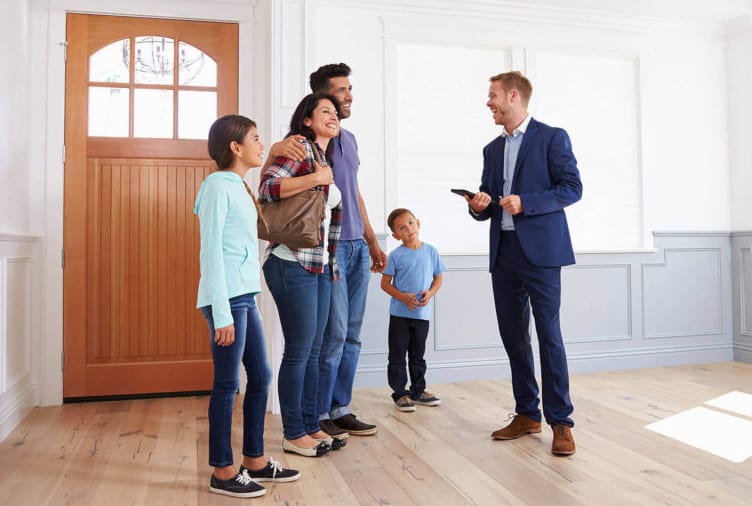What is a real estate showing?
A real estate showing is any opportunity you give a potential buyer to see your home in person. It could be an open house, a lockbox tour or a private showing.
If you’re looking for a conventional buyer, and if you want to encourage multiple offers, avoiding showings isn’t really an option. Sight-unseen sales are extremely rare, unless you’re dealing with international or out-of-town buyers.
Whether you’re looking forward to showing off your home to potential buyers or dreading the process, here’s how to show a home for sale.
What is an open house?
In an open-house format, all potential buyers come at once, usually over the course of a three- to four-hour period on a weekend afternoon. A well-attended open house can help you streamline the showing process, since more people can see your home at once. It can also spark a competitive spirit in potential buyers, as they may want to rush to get their offer in before anyone else.
Open houses can minimize the inconvenience of showings — you’ll only have to get your house buyer-ready one time, and you’ll know the schedule ahead of time. Open houses can also help you capture potential buyers who might just be out exploring the neighborhood.
A downside to open houses — not everyone who attends your open house is an interested or qualified buyer. Open houses attract a lot of lookie-loos who might not actually want to buy your house.
What is a lockbox house showing?
More convenient than private tours, lockbox tours allow potential buyers to look at your home with their own agent. Since they can access your home with a lockbox, this setup allows more flexibility in scheduling. They can let themselves in rather than waiting for your agent to show the house.
Buyers often like lockbox tours because they’re able to speak freely about their opinions on the house without worrying about the seller’s agent listening.
One downside to consider is potential security issues that come with letting strangers into your home while you’re not there — more on safety precautions later.
What is a private house showing?
Perhaps the most common home tour arrangement, a private house showing is when your agent gives buyers a personal tour of the home. Sometimes, serious buyers request a private tour of the home after attending an open house — this is a good sign!
A private tour allows sellers and their agents to control the showing. The agent can answer all of the buyer’s questions in real time, point out your home’s best features, and make sure nothing gets damaged or stolen.
One downside to private tours is that since you or your agent will be on-site, buyers may feel uncomfortable getting a true feel for the home, which might include opening closets, spending time in every room, checking out storage spaces, and talking through their likes and dislikes.
Preparing to show a house for sale
House showings can be scheduled without much advance notice, so ideally, your home should be kept spotless while it’s listed for sale. You want to be prepared to show the house whenever someone calls.
If you have an open house scheduled, you have the benefit of knowing how much prep time you have. But with lockbox or private tours, you may have only between half an hour and a few hours notice. Here are some tips for preparing your home for showings.
Before the first showings
Clean thoroughly: Steam the carpets, mop or vacuum hard floors, clean windows, polish appliances and give the bathrooms a serious scrubbing.
Secure your belongings: Lock away any valuables to avoid theft of expensive items or private information.
Have a plan for pets and kids: Your showings are much more likely to go smoothly if family pets or young family members aren’t around.
Depersonalize and declutter: Room by room, remove little items that clutter up the space and make rooms look smaller. Remove family photos and personalized decor — you want buyers to picture themselves living in the home, and they can’t do that with your family pictures on the wall.
Rearrange furniture as needed: Remove furniture to make rooms seem bigger, and swap pieces in and out of different rooms to give each space an obvious purpose. For example, add a desk and chair to a bonus room to show it as a home office, or move a twin bed into an empty bedroom.
Don’t forget the outside: Curb appeal helps your home make its first impression, and your to-do list will vary seasonally. Common tasks include planting flowers, pulling weeds, mowing the lawn, raking and shoveling snow.
Keep storage spaces tidy: Every buyer is looking for a home with plenty of storage, which means they’re going to be opening your closets, pantry and garage doors. Don’t just shove extra belongings into closets — they need to look tidy and not overfilled.
Highlight the best features: Identify the features that are most attractive about your home. If you have beautiful hardwood floors, remove the rug that’s covering them up. Love your stainless steel appliances? Don’t hide them behind refrigerator magnets or dish towels.
Ongoing home showing tips
Keep family members in the loop: Make sure everyone who lives in your house knows when showings are scheduled so they can keep their spaces tidy.
Do a daily cleaning: Be vigilant about cleaning up daily messes, like crumbs on the table, coffee spills on the counter or toothpaste drips in the bathroom.
Avoid strong-smelling foods: Keep your meal prep simple and avoid foods that leave long-lasting odors.
Keep pet areas clean: Clean up after your pets immediately and wash their bedding regularly.
Make it light and bright: Open blinds and curtains to let in as much natural light as possible, and leave lights on when you vacate for a showing.
Hide pet food or litter: Not everyone is a dog or cat person! Buyers shouldn’t even be able to tell you have a pet.
Empty trash cans: To avoid bad odors, regularly empty trash cans in every room.
Set the thermostat to a comfortable temperature: If tours will be happening when you’re at work and you usually turn the heat off, keep it on so that buyers will be comfortable during their tour. Same goes for the summer — if you have a nice, cool house, buyers will be inclined to stay longer and enjoy the home.
Provide refreshments: Make your home feel welcoming with snacks, candy and desserts. Don’t forget to leave a garbage can in plain sight so visitors can clean up after themselves.
Consider seasonal ambience: A fall fire in the fireplace, winter hot chocolate or freshly cut spring flowers are always nice touches.
Ask the neighbors for help: If you’re on good terms with your neighbors, you can ask for their cooperation in keeping their dogs from barking.
Common showing mistakes
Since showings are such an important part of a buyer’s decision-making process, it’s important that you avoid common mistakes that can negatively affect how your home is perceived.
Try your best to avoid the following home showing pitfalls:
Not accommodating showings: Sure, showings can be a pain to prepare for, and they can be scheduled last minute, but it’s in your best interest to be flexible with your potential buyer’s schedule whenever possible. They’re usually looking at multiple homes in a day, and they may not circle back to see your home again if it’s not available when they ask to see it.
Asking buyers to take their shoes off: While it would keep your floors a bit cleaner, it’s a mistake to ask buyers to take their shoes off, as it might make them feel unwelcome. If you’re concerned about wet or muddy feet, you can leave a basket of disposable booties out. Also, make sure to have a good mat at the front door.
Attending your own showing: It’s considered a faux pas for sellers to be present during showings at their home, as it can make buyers feel uncomfortable. If you’re selling your home on your own, without the help of an agent, consider using a lockbox for showings. If you’re a for-sale-by-owner (FSBO) seller and you have to host the showing yourself, don’t hover. Let visitors explore your house on their own, and just be available to answer questions.
Using too many candles and air fresheners: Many people dislike or are allergic to strong fragrances. And strong scents can make buyers think you’re trying to cover up bad smells. Instead of candles and air fresheners, try fresh flowers, freshly baked cookies or coffee — subtle is better.
Taking feedback personally: It can be hard to hear criticism about your home, but it can be helpful. For example, if you find out a buyer said the carpets looked dirty, you can clean them before the next showing.
Failing to declutter and depersonalize: A messy home makes buyers think you’re not taking good care of it, and it’s very hard for buyers to picture the house as their own if your stuff is everywhere.
Removing too much: On the flip side, you don’t want to completely empty your home — there’s a reason home staging is popular. Strategically placed furniture helps define spaces and shows buyers how they might use a particular room. And by leaving beds in bedrooms, you show buyers what type and size of furniture might fit. Finally, empty homes don’t give off a warm and welcoming vibe.
How to show a house for sale by owner
When you sell a house with a listing agent, they usually handle the private tours and open houses. But when you’re selling FSBO, you’re on your own.
Don’t forget these important to-dos:
Prepare flyers: Keep pamphlets or listing sheets on hand to give to buyers and their agents. Make sure they include full-color photos.
Have a sign-in sheet: Ask visitors to sign in with their contact info so you can follow up or reach out if something goes missing.
Ask for feedback: After the showing, contact the agents who attended to see what their buyers thought of the home. There may be actionable feedback that could help your home appeal to more buyers.
Real estate showing safety precautions
No matter what kind of showing you’re planning, it’s important to keep a few safety precautions in mind.
Before showing your home for sale
Lock away valuables.
Secure sensitive financial documents.
Lock up or remove medication.
Keep the home’s interior and exterior well-lit, especially during evening showings.
Remove any decor with your family members’ names and pictures, especially kids’.
Box up belongings you don’t need — this will keep your belongings safe and help you prepare for your move!
During a home showing
If you’re the one running the showing, either because your home doesn’t have a lockbox or because you’re selling on your own, follow these safety precautions:
Don’t let people in who aren’t scheduled (unless it’s an open house).
Ask a friend or family member to keep you company so you’re not in the house alone.
Keep a record of who comes through the door, even for private tours.
Inform nearby neighbors of showings or open houses.
Trust your gut — red flags include people checking doors, windows and security systems, one person trying to distract you while the other tours the home, or someone asking about your personal schedule (e.g., when you’re home or when you’re gone).
Lock up your home right after the tour has concluded.

